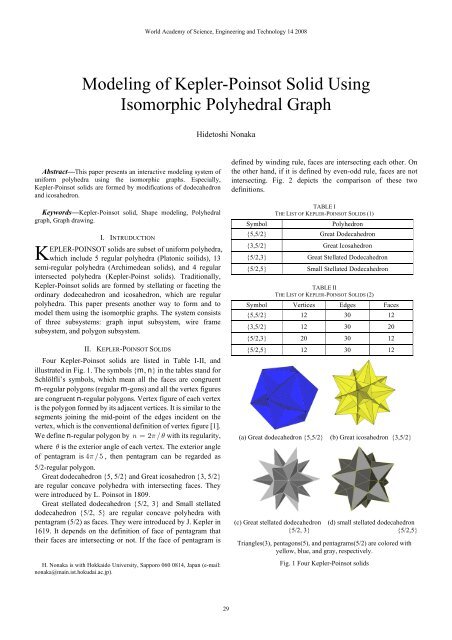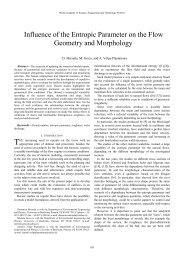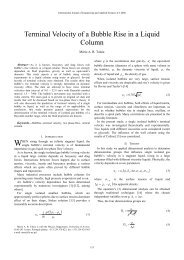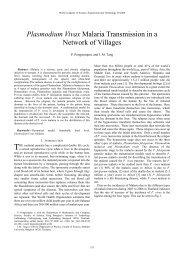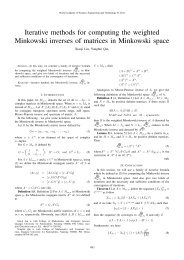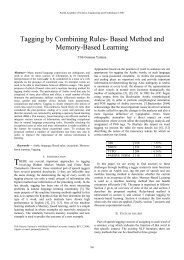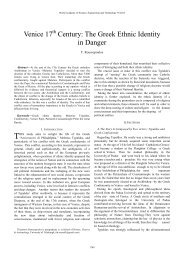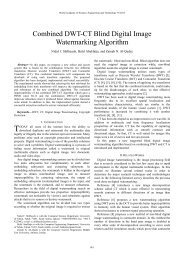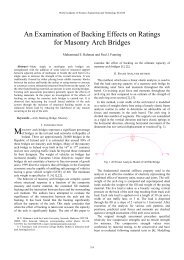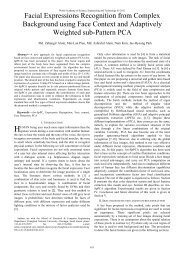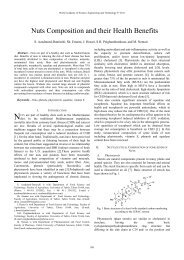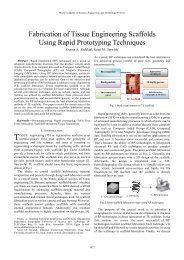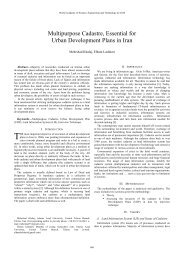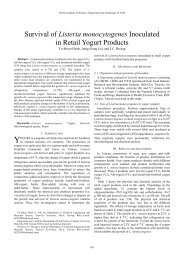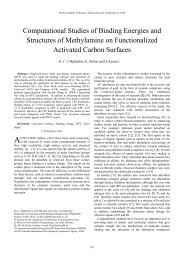Modeling of Kepler-Poinsot Solid Using Isomorphic Polyhedral Graph
Modeling of Kepler-Poinsot Solid Using Isomorphic Polyhedral Graph
Modeling of Kepler-Poinsot Solid Using Isomorphic Polyhedral Graph
You also want an ePaper? Increase the reach of your titles
YUMPU automatically turns print PDFs into web optimized ePapers that Google loves.
Abstract—This paper presents an interactive modeling system <strong>of</strong><br />
uniform polyhedra using the isomorphic graphs. Especially,<br />
<strong>Kepler</strong>-<strong>Poinsot</strong> solids are formed by modifications <strong>of</strong> dodecahedron<br />
and icosahedron.<br />
Keywords—<strong>Kepler</strong>-<strong>Poinsot</strong> solid, Shape modeling, <strong>Polyhedral</strong><br />
graph, <strong>Graph</strong> drawing.<br />
I. INTRUDUCTION<br />
EPLER-POINSOT solids are subset <strong>of</strong> uniform polyhedra,<br />
K which include 5 regular polyhedra (Platonic soilids), 13<br />
semi-regular polyhedra (Archimedean solids), and 4 regular<br />
intersected polyhedra (<strong>Kepler</strong>-Poinst solids). Traditionally,<br />
<strong>Kepler</strong>-<strong>Poinsot</strong> solids are formed by stellating or faceting the<br />
ordinary dodecahedron and icosahedron, which are regular<br />
polyhedra. This paper presents another way to form and to<br />
model them using the isomorphic graphs. The system consists<br />
<strong>of</strong> three subsystems: graph input subsystem, wire frame<br />
subsystem, and polygon subsystem.<br />
II. KEPLER-POINSOT SOLIDS<br />
Four <strong>Kepler</strong>-<strong>Poinsot</strong> solids are listed in Table I-II, and<br />
illustrated in Fig. 1. The symbols {m, n} in the tables stand for<br />
Schlölfli’s symbols, which mean all the faces are congruent<br />
m-regular polygons (regular m-gons) and all the vertex figures<br />
are congruent n-regular polygons. Vertex figure <strong>of</strong> each vertex<br />
is the polygon formed by its adjacent vertices. It is similar to the<br />
segments joining the mid-point <strong>of</strong> the edges incident on the<br />
vertex, which is the conventional definition <strong>of</strong> vertex figure [1].<br />
We define n-regular polygon by n = 2 π/ θ with its regularity,<br />
where θ is the exterior angle <strong>of</strong> each vertex. The exterior angle<br />
<strong>of</strong> pentagram is 4 π /5,<br />
then pentagram can be regarded as<br />
5/2-regular polygon.<br />
Great dodecahedron {5, 5/2} and Great icosahedron {3, 5/2}<br />
are regular concave polyhedra with intersecting faces. They<br />
were introduced by L. <strong>Poinsot</strong> in 1809.<br />
Great stellated dodecahedron {5/2, 3} and Small stellated<br />
dodecahedron {5/2, 5} are regular concave polyhedra with<br />
pentagram (5/2) as faces. They were introduced by J. <strong>Kepler</strong> in<br />
1619. It depends on the definition <strong>of</strong> face <strong>of</strong> pentagram that<br />
their faces are intersecting or not. If the face <strong>of</strong> pentagram is<br />
H. Nonaka is with Hokkaido University, Sapporo 060 0814, Japan (e-mail:<br />
nonaka@main.ist.hokudai.ac.jp).<br />
World Academy <strong>of</strong> Science, Engineering and Technology 14 2008<br />
<strong>Modeling</strong> <strong>of</strong> <strong>Kepler</strong>-<strong>Poinsot</strong> <strong>Solid</strong> <strong>Using</strong><br />
<strong>Isomorphic</strong> <strong>Polyhedral</strong> <strong>Graph</strong><br />
Hidetoshi Nonaka<br />
29<br />
defined by winding rule, faces are intersecting each other. On<br />
the other hand, if it is defined by even-odd rule, faces are not<br />
intersecting. Fig. 2 depicts the comparison <strong>of</strong> these two<br />
definitions.<br />
TABLE I<br />
THE LIST OF KEPLER-POINSOT SOLIDS (1)<br />
Symbol Polyhedron<br />
{5,5/2} Great Dodecahedron<br />
{3,5/2} Great Icosahedron<br />
{5/2,3} Great Stellated Dodecahedron<br />
{5/2,5} Small Stellated Dodecahedron<br />
TABLE II<br />
THE LIST OF KEPLER-POINSOT SOLIDS (2)<br />
Symbol Vertices Edges Faces<br />
{5,5/2} 12 30 12<br />
{3,5/2} 12 30 20<br />
{5/2,3} 20 30 12<br />
{5/2,5} 12 30 12<br />
(a) Great dodecahedron {5,5/2} (b) Great icosahedron {3,5/2}<br />
(c) Great stellated dodecahedron (d) small stellated dodecahedron<br />
{5/2, 3} {5/2,5}<br />
Triangles(3), pentagons(5), and pentagrams(5/2) are colored with<br />
yellow, blue, and gray, respectively.<br />
Fig. 1 Four <strong>Kepler</strong>-<strong>Poinsot</strong> solids
(a) Winding rule (b) Even-odd rule<br />
Fig. 2 Two alternative definitions <strong>of</strong> face or “inside” <strong>of</strong> pentagram<br />
Traditionally, <strong>Kepler</strong>-<strong>Poinsot</strong> solids are formed and defined<br />
by stellating and extending <strong>of</strong> faces <strong>of</strong> dodecahedron or<br />
icosahedron as the core polyhedron. As is shown in Fig. 3,<br />
Small stellated dodecahedron, Great dodecahedron, and Great<br />
stellated dodecahedron are formed from Dodecahedron. By<br />
extending the faces <strong>of</strong> icosahedron, five faces meet again<br />
outside <strong>of</strong> Icosahedron and Great icosahedron is obtained. Fig.<br />
4 shows the comparison <strong>of</strong> the size <strong>of</strong> the core icosahedron and<br />
Great icosahedron.<br />
Fig. 3 Stellating and extending the face <strong>of</strong> dodecahedron<br />
Fig. 4 Comparison <strong>of</strong> the size <strong>of</strong> the core icsahedron and Great<br />
icosahedron<br />
World Academy <strong>of</strong> Science, Engineering and Technology 14 2008<br />
30<br />
III. ISOMORPHIC POLYHEDRAL GRAPH<br />
Great dodecahedron fails to satisfy the Euler polyhedral<br />
equation. It has 12 pentagons, which is the origin <strong>of</strong> its name,<br />
but corresponding graph is isomorphic to icosahedron. Great<br />
icosahedron has 20 triangles, and the corresponding graph is<br />
also isomorphic to icosahedron. Great stellated dodecahedron<br />
has 12 pentagram, and the corresponding graph is isomorphic<br />
to dodecahedron. Small stellated dodecahedron has 12<br />
pentagram, but the corresponding graph is isomorphic to<br />
icosahedron. It fails to satisfy the Euler polyhedral equation.<br />
Fig. 5 illustrates the isomorphic graphs <strong>of</strong> <strong>Kepler</strong>-<strong>Poinsot</strong><br />
solids. And Fig. 6 shows the screen shot <strong>of</strong> graph input<br />
subsystem.<br />
(a) {5/2, 3} (b) {5, 5/2}, {3, 5/2}, {5/2, 5}<br />
Fig. 5 <strong>Polyhedral</strong> graphs isomorphic to <strong>Kepler</strong>-<strong>Poinsot</strong> solids<br />
Fig. 6 Snapshot <strong>of</strong> graph input subsystem<br />
IV. WIRE FRAME POLYHEDRA<br />
In order to form a wire frame polyhedron from a<br />
corresponding graph, we define three binary relations between<br />
two vertices: adjacent, neighbor, and diameter (Fig. 7).<br />
(a) adjacent (b) neighbor (c) diameter<br />
Fig. 7 Binary relations between two vertices
⎧⎪true adjacent(,) u v = ⎪<br />
⎨<br />
⎪⎪⎩<br />
false<br />
(,) u v ∈ E<br />
otherwise<br />
⎧⎪true ⎪<br />
neighbor(,) u v = ⎪<br />
⎨<br />
⎪<br />
⎪⎩<br />
false<br />
(,) u v ∉ E ∧<br />
∃w.(( u, w) ∈ E ∧<br />
(, vw) ∈ E)<br />
otherwise<br />
⎧ ⎪true<br />
diameter(,) u v = ⎪<br />
⎨<br />
⎪⎪⎩<br />
false<br />
length(,) u v = dmr( G)<br />
otherwise<br />
The relation adjacent corresponds to the equilaterality <strong>of</strong><br />
edges. The relation neighbor corresponds to the vertex figure.<br />
The relation diameter corresponds to the circumsphere <strong>of</strong><br />
polyhedron. Virtual springs are applied between vertices<br />
according to three relations and Hook’s law. Let L and k be<br />
natural length <strong>of</strong> virtual spring and spring constant, and each<br />
subscript a, n, d corresponds to adjacent, neighbor, and<br />
diameter, respectively. vi, i = 0,1, , p −1stands<br />
for the 3<br />
dimensional coordinate <strong>of</strong> vertex vi∈ V . Then the total elastic<br />
potential E is given as follows.<br />
E = Ea + En + Ed<br />
Ea ka<br />
=<br />
2 ∑ ( La−vi −vj<br />
)<br />
i< j ∧adjacent(<br />
vi, vj)<br />
k<br />
E ∑ ( L v v )<br />
n<br />
n = n− i − j<br />
2 i< j∧neighbor( vi, vj)<br />
k<br />
E ∑ ( L v v )<br />
d<br />
d = d− i − j<br />
2 i< j ∧diameter(<br />
vi, vj)<br />
Fig. 8 shows a screen shot <strong>of</strong> wire frame subsystem with tool<br />
windows, and Fig. 9 shows the wire frames <strong>of</strong> <strong>Kepler</strong>-<strong>Poinsot</strong><br />
solids generated by the system using simulated elasticity.<br />
Fig. 8 Screen shot <strong>of</strong> wire frame subsystem with elasticity control tool<br />
and optional monitor window<br />
World Academy <strong>of</strong> Science, Engineering and Technology 14 2008<br />
2<br />
2<br />
2<br />
31<br />
(a) {5, 5/2} (b) {3, 5/2}, {5/2, 5}<br />
(c) {5/2, 3}<br />
Fig. 8 Wire frames <strong>of</strong> <strong>Kepler</strong>-<strong>Poinsot</strong> solids<br />
We can see in Fig. 8, wire frame <strong>of</strong> Great dodecahedron {5,<br />
5/2} is identical to that <strong>of</strong> icosahedron {3, 5}. Wire frame <strong>of</strong><br />
Great icosahedron {3, 5/2} and small stellated dodecahedron<br />
{5/2, 5} are also congruent. Vertex positions <strong>of</strong> above four<br />
polyhedral are equivalent. And vertex positions <strong>of</strong> Great<br />
stellated dodecahedron are equal to those <strong>of</strong> dodecahedron.<br />
V. MODELING OF KEPLER-POINSOT SOLIDS<br />
The final step is detecting and selecting appropriate faces.<br />
Fig. 9 shows snapshots <strong>of</strong> polygon subsystem.<br />
Fig. 9 Screenshots <strong>of</strong> polygon subsystem<br />
Three <strong>Kepler</strong>-<strong>Poinsot</strong> solids generated from icosahedral graph
Detecting n-regular polygon is equivalent to finding simple<br />
closed path (cycle) with length n. Firstly, detecting triangles<br />
from Great icosahedron is equal to detecting triangles from<br />
icosahedron. Secondly, detecting pentagrams from Great<br />
stellated dodecahedron is common with detecting pentagons<br />
from dodecahedron. Lastly, detecting pentagons from Great<br />
dodecahedron is common with detecting pentagrams from<br />
Small stellated dodecahedron. In the last case, five vertices<br />
forming pentagon or pentagram are neighbor <strong>of</strong> another vertex,<br />
therefore, by reordering <strong>of</strong> these five vertices according to<br />
adjacency, correct face is detected.<br />
The faces <strong>of</strong> Great dodecahedron and Great icosahedron are<br />
intersected each other, then hidden surface removal according<br />
the depth is required for rendering. Z-buffer algorithm is<br />
applicable for this purpose (for example [9]), but exterior<br />
elements <strong>of</strong> faces can be calculated by the coordinate <strong>of</strong><br />
vertices, therefore, it can be achieved without z-buffer or<br />
graphics accelerator for real-time rendering.<br />
In the case <strong>of</strong> Great dodecahedron, exterior surface is<br />
obtained as each pentagon subtracted by the pentagram formed<br />
by the same vertices. Exposed fragments <strong>of</strong> Great icosahedron<br />
are calculated as follows (Fig. 10).<br />
B<br />
G<br />
E<br />
C<br />
R<br />
P<br />
O F Q D<br />
A<br />
Fig. 10 Nine exposed fragments <strong>of</strong> triangle ΔOAB surrounding the<br />
great icosahedron (shadowed area)<br />
Let abc , , , , r be the position vector <strong>of</strong> each point<br />
ABC , , , , R in Fig.10, then they are expressed by a and b as<br />
follows:<br />
5− c =<br />
5<br />
5 3 5 −5<br />
a + b, d =<br />
10<br />
5 − 1<br />
a<br />
2<br />
e =<br />
5 5−2 5<br />
a + b , f<br />
5 5<br />
3 −<br />
=<br />
2<br />
5<br />
a ,<br />
5 −<br />
g =<br />
10<br />
5 3 5 −5<br />
a + b .<br />
10<br />
3 +<br />
p =<br />
8<br />
5 3 −<br />
a +<br />
8<br />
5 1<br />
b, q = a ,<br />
2<br />
1 3− r = a +<br />
4 8<br />
5<br />
b<br />
Three points P, Q, R are used for determining the depth<br />
World Academy <strong>of</strong> Science, Engineering and Technology 14 2008<br />
32<br />
order <strong>of</strong> three fragments, which form a concave region. ΔDPC<br />
and ΔFRG are right-angled triangles and axisymmetrical to<br />
ΔDQE and ΔFQE, respectively.<br />
VI. RELATED WORK<br />
In order to form a wire frame polyhedron from a<br />
corresponding graph, simulated elasticity or virtual spring is<br />
used in several researches. For example, Chen et al. [10]<br />
applied imaginary springs between the vertices and the origin,<br />
and also between the pair <strong>of</strong> adjacent vertices. It is sufficient for<br />
triangular polyhedral or deltahedra. It include tetrahedron,<br />
octahedron, and icosahedron. Tyler [11] developed a tensetrity<br />
simulator “springie”, which can model arbitrary stable wire<br />
frame polyhedral by designing the structure to satisfy the<br />
condition <strong>of</strong> tensegrity. On the other hand, in the presented<br />
system, tensegrity is obtained semi-automatically using three<br />
binary relations between two vertices.<br />
In the case <strong>of</strong> general polyhedra, the solution <strong>of</strong> face<br />
detection from an arbitrary planar graph is not unique. There<br />
are various researches for detecting polygons from wire frames,<br />
especially in the field <strong>of</strong> computer graphics. For example,<br />
Inoue et al. proposed an effective method <strong>of</strong> solid model<br />
reconstruction from planar graphs with exhaustive collection<br />
and pruning down [12]. On the other hand, in our purpose, the<br />
graphs are limited to icosahedral and dodecahedral graphs,<br />
therefore, the algorithm is quite simple. The same approach to<br />
semi-regular polyhedra has been presented by the author [13].<br />
There is also theoretical research on the relation between<br />
polyhedral graph and abstract polyhedra by Grünbaum [14].<br />
REFERENCES<br />
[1] H. S. M. Coxeter, “Regular Polytopes”, Dover Publications, 1973<br />
[2] P. Martin, and D. Martin, “PolyFormes: S<strong>of</strong>tware for the declarative<br />
modelling <strong>of</strong> polyhedra”, The Visual Computer, 15 (2), pp. 55-76, 1999<br />
[3] G. W. Hart, and H. Picciotto, “Zome Geometry: Hands on Learning With<br />
Zome Models”, Key Curriculum Pr., 2001.<br />
[4] G. W. Hart, “Virtual Polyhedra --- The Encyclopedia <strong>of</strong> Polyhedra”,<br />
http://www.georgehart.com/virtual-polyhedra/vp.html<br />
[5] G. W. Hart, “Conway Notation for Polyhedra”, available at the URL:<br />
http://www.georgehart.co/virtual-polyhedra/conway_notation.html”<br />
[6] A. Holden, “Shapes, Space, and Symmetry”, Columbia University Press,<br />
1971<br />
[7] H. S. M. Coxeter, et al., “Fifty-Nine Icosahedra”, Tarquin Publications,<br />
Norfolk, England, 1999<br />
[8] J. Skilling, “The Complete Set <strong>of</strong> Uniform Polyhedra”, Philosophical<br />
Transactions <strong>of</strong> the Royal Society <strong>of</strong> London, Series A, Mathematical and<br />
Physical Science, 278, pp. 111-135, 1975<br />
[9] T. A. Möller, and E. Haines, “Real-time Rendering”,A K Peters, Ldt.,<br />
2002<br />
[10] J. X. Chen, Y. Yang, and X. Wang, “Phisics-Based <strong>Modeling</strong> and<br />
Real-Time Simulation”, Computing in Science & Engineering, 3, pp.<br />
98-102, 2001.<br />
[11] T. Tyler, “Springie: A tensegrity simulator using Java, VRML and POV<br />
Ray”, http://springie.com/<br />
[12] K. Inoue, K. Shimada, and K. Chilaka, “<strong>Solid</strong> Model Reconstruction <strong>of</strong><br />
Wireframe CAD Models Based on Topological Embeddings <strong>of</strong> Planar<br />
<strong>Graph</strong>s”, Journal <strong>of</strong> Mechanical Design, 125, pp. 434-442, 2003.<br />
[13] H. Nonaka, “Detection <strong>of</strong> Faces in Wire-Frame Polyhedra”, Proceedings<br />
<strong>of</strong> International Conference on Computer <strong>Graph</strong>ics Theory and<br />
Applications, pp. 134-137, Jan. 2008.<br />
[14] B. Grünbaum, “<strong>Graph</strong>s <strong>of</strong> polyhedra; polyhedra as graphs”, Discrete<br />
Mathematics, 307, pp. 445-463, 2007.


